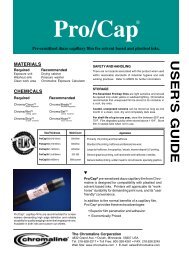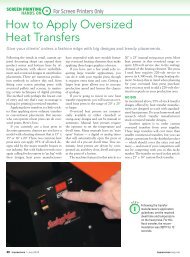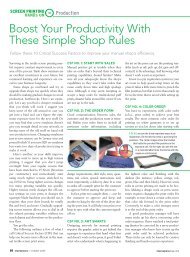English.pdf - Newman Roller Frames
English.pdf - Newman Roller Frames
English.pdf - Newman Roller Frames
You also want an ePaper? Increase the reach of your titles
YUMPU automatically turns print PDFs into web optimized ePapers that Google loves.
Continue with either of the two long rollers, calling it<br />
roller #3. The last remaining roller will be roller #4. Place<br />
the tension meter in the center of the screen. The arrows<br />
on the base of the meter should be pointing between<br />
rollers #3 and #4, in order to correctly read the screen<br />
tension generated when roller #3 is rotated.<br />
Unlock the bolts with the torque wrench and using the<br />
SDI open end combination wrench to rotate the roller,<br />
rotate the roller until you read 50% of the initial tensioning<br />
level on the dial face of the tension meter. Retorque<br />
the bolts, as before.<br />
However, based on these readings, you may want to increase<br />
or decrease the rotation for the roller opposite the<br />
square bar for your next screen. In this way, all of your<br />
mesh counts will have a specific calibration and can be<br />
documented in writing for future use.<br />
IMPORTANT: Check tension not only in the center of the<br />
screen but throughout the print area of your screen, making<br />
sure to include the outside corners. Check both directions<br />
of the mesh. You are looking for consistency within<br />
2 N/cm. If this is not the case, the only way to correct the<br />
problem is through more careful and precise mesh insertion.<br />
After Completing the Initial Tensioning Process: Using a<br />
marker at one corner of the mesh, write the mesh count<br />
and indicate the time and tension level now.<br />
Continue with the last roller #4. Before using the torque<br />
wrench to loosen the second bolt on this roller, be sure to<br />
place the SDI open end combination wrench on the<br />
endplug to prevent the roller from rotating backwards.<br />
Tension the mesh to 100% of the initial tension level.<br />
8.- Verifying that the frames are flat: Elevate the frame<br />
using pieces of squeegee below each corner. To check if<br />
the frame is flat, use your hands to tap lightly across the<br />
diagonal corners for any rocking movement.<br />
With the tension meter still in the center of the screen,<br />
turn the meter 90 degrees, with the arrows on the meter<br />
base pointing between the long rollers. Verify that the<br />
tension levels are equal in both directions, with a difference<br />
of no more than 2 N/cm between them. It is not<br />
necessary to undo the fabric and start over if the tension<br />
varies more than 2 N/cm because when it is time to<br />
retension the screen, the direction that is lowest will be<br />
the only side turned.<br />
Stretch Devices, Inc. • Philadelphia, PA, USA • 1-800-523-3694 • (215) 739-3000 • Fax (215) 739-3011 • Page 6





